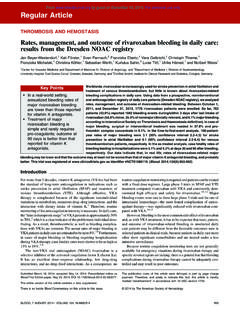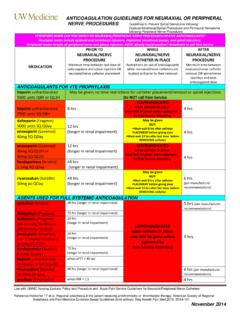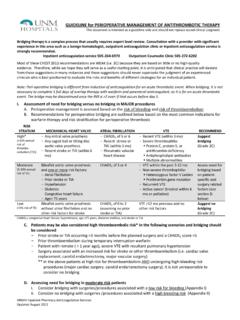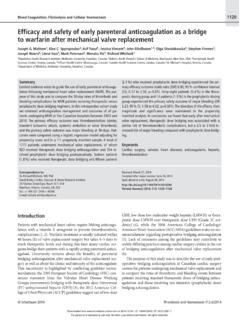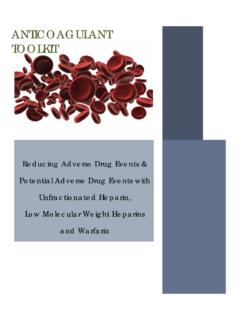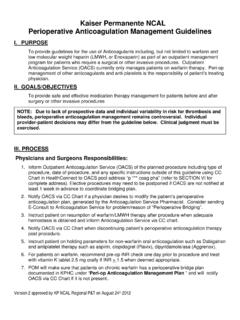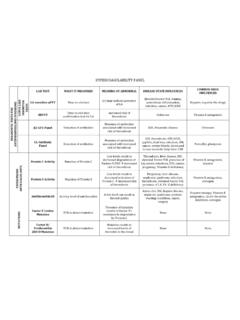Transcription of Therapeutic Dosing of Unfractionated Heparin – Pediatric ...
1 Therapeutic Dosing of Unfractionated Heparin Pediatric inpatient . clinical Practice Guideline Cover Sheet Target Population: inpatient CPG Contact: Name: Sara Shull, PharmD, MBA, Drug Policy Manager Phone Number: 608-262-1817. Email address: Guideline Author(s): Anne Rose, Nicole Lubcke, Coordinating Team Members: Carol Diamond, MD. Scott Hagen, MD. Review Individuals/Bodies: inpatient Anticoagulation Committee Committee Approvals/Dates: Anticoagulation Committee: July 2012; June 2013. Pharmacy and Therapeutics: August 2012; July 2013. Release Date: August 2012. UW Health University of Wisconsin Hospital and Clinics . clinical Practice Guideline (CPG). Executive Summary Guideline Title: Therapeutic Dosing of Unfractionated Heparin Pediatric inpatient CPG. Guideline Overview The following guideline provides recommendations for how to initiate, dose adjust and monitor a Therapeutic Unfractionated Heparin infusion in Pediatric patients.
2 Practice Recommendations 1. Initial Heparin Bolus Initial bolus dose of 75 units/kg will result in a Therapeutic anti-Xa in 90% of children Bolus doses are based on actual body weight Boluses should be used with caution or avoided in patients with the following: Neonates and premature neonates Stroke Active bleeding High bleeding risk 2. Initiation of Heparin Infusion Initial infusion rate is based on the age of the child Document infusion rates in units/kg/hr Table 1. Initial Heparin Infusion Rates Bolus Dose Maximum Bolus Initial Infusion Age (units/kg) (units) (units/kg/hr). Birth to 12 months 75 1,500 28. Children > 1 year 75 5,000 20. Children > 12 years 80 10,000 18.. 3. Algorithm for adjusting Therapeutic Heparin infusion Table 2. Heparin Infusion Dose Adjustments Heparin Level by Bolus/Hold Infusion Rate Change Anti-Xa (IU/mL). < Bolus 50 units/kg & inform MD n 3 units/kg/hr 0 n 2 units/kg/hr - 0 No Change; Therapeutic Range - 0 by 2 unit/kg/hr Hold infusion 30 min & inform MD by 2 units/kg/hr > Hold infusion 1 hour & inform MD by 3 units/kg/hr UW Health University of Wisconsin Hospital and Clinics.
3 Therapeutic Dosing of Unfractionated Heparin Pediatric inpatient clinical Practice Guideline A. Scope 1. hospitalized patients receiving intravenous Unfractionated Heparin intended for Therapeutic Dosing B. Methodology 1. A modified Grading of Recommendations Assessment, Development and Evaluation (GRADE) developed by the American Heart Association and American College of Cardiology (Figure 1.) has been used to assess the Quality and Strength of the Evidence in this clinical Practice . C. Definitions 1. Therapeutic range - No outcome studies have determined a Therapeutic range for Unfractionated Heparin in Pediatric patients. With the absence of Pediatric specific range information, extrapolation of the adult Therapeutic range is Unfractionated Heparin infusion: Heparin level by anti-Xa of Low molecular weight Heparin : Heparin level by anti-Xa of unit/mL based on twice daily Dosing .
4 2. 2. Heparin levels by anti-Xa levels have been preferred in Pediatric intensive care units due to the potential lack of correlation between anti-Xa and aPTT UW Health University of Wisconsin Hospital and Clinics . D. Introduction Neonates and children differ in their pharmacologic response to medications. The following guideline provides recommendations for how to initiate, dose adjust and monitor a Therapeutic Unfractionated Heparin infusion for a Pediatric patient. E. Recommendations 1. Therapeutic Heparin infusions should be ordered by an order set that includes a dose adjustment algorithm, specified lab monitoring, and patient assessment: (Class I, Level C). While discouraged, if patient circumstances require Heparin Dosing that differs from established algorithms, specific orders must be written. Consider consulting Pediatric hematology for patients who may not fit into the standard algorithm (Class 1, Level C).
5 Separate Heparin order sets are available for patients on extracorporeal membrane oxygenation. 2. Baseline Laboratory Monitoring STAT anti-Xa and PT/INR if not available (Class IIa, Level B). STAT CBC and platelet, if not available (Class IIa, Level B). Labs must be drawn prior to initiating the Heparin infusion Optimal sample is from a fresh venipuncture site 3. Initial Heparin Bolus 2. Initial bolus dose of 75 units/kg will result in a Therapeutic anti-Xa in 90% of children (Class IIb, Level C). Bolus doses are based on actual body weight Boluses should be used with caution or avoided in patients with the following: (Class IIb, Level C). Neonates and premature neonates Stroke Active bleeding High bleeding risk Round the bolus dose to the nearest 10 units for ease of preparation Document the administered bolus in the flow sheet Use Heparin 1000 units/mL vial for bolus from floor stock.
6 4. Initiation of Heparin Infusion Initial infusion rate is based on the age of the child2 (Class IIa, Level B). Document infusion rates in units/kg/hr Table 1. Initial Heparin Infusion Rates Maximum Bolus Dose Initial Infusion Age Bolus (units/kg) (units/kg/hr). (units). Birth to 12 months 75 1,500 28. Children > 1 year 75 5,000 20. Children > 12 years 80 10,000 18. 5. Titration of Heparin Infusion (Class IIb, Level C). Do NOT monitor the Heparin infusion with both aPTT and anti-Xa Check STAT anti-Xa after initiation of the infusion and after any rate change Every 8 hours for children < 1 year of age Every 4 hours for children > 1 year of age Use Table 2 for dose adjustments Once 3 consecutive anti-Xa levels are Therapeutic it is recommended to check anti-Xa level every 24 hours with the am labs UW Health University of Wisconsin Hospital and Clinics . If a rate adjustment becomes necessary or the infusion is held for any reason and restarted, recheck anti-Xa level and repeat the above process.
7 6. Algorithm for adjusting Therapeutic Heparin infusion (Class IIb, Level C). Table 2. Heparin Infusion Dose Adjustments Heparin Level by Bolus/Hold Infusion Rate Change Anti-Xa (IU/mL). < Bolus 50 units/kg & inform MD n 3 units/kg/hr 0 n 2 units/kg/hr - 0 No Change; Therapeutic Range - 0 by 2 unit/kg/hr Hold infusion 30 min & inform MD by 2 units/kg/hr > Hold infusion 1 hour & inform MD by 3 units/kg/hr If a Therapeutic goal is not reached within 24 hours with correct titration the patient may not be an appropriate candidate for adjustments based on the Heparin algorithm. Recommend consultation with Pharmacy and/or Hematology for assistance with Dosing . (Class IIb, Level C).. 7. Maintenance Laboratory Monitoring6 (Class I, Level A). Optimal sample is from a fresh venipuncture site Sample should not be drawn from an IV infusing Therapeutic Heparin Hemoglobin and platelets must be followed 24 hours after initiating Heparin therapy and every other day thereafter for up to 14 days or until therapy is discontinued 8.
8 Patient Assessment (Class IIb, Level C). Every eight hours: Inspect line/surgical/wound sites for bleeding and check patient for symptoms indicating bleeding such as hematomas, bruising, and respiratory symptoms. Contact MD for any signs of bleeding. 9. Provider should be notified if: (Class I, Level C). Baseline anti-Xa > unit/mL or baseline INR > 9. Platelet count decreases > 50% from baseline or if count falls below 100 x10 /L. Hemoglobin decreases by > 2 g/dL from baseline Anti-Xa level is < IU/mL or > IU/mL. Patient has any deterioration in neurologic status 10. Therapeutic Heparin infusions should be used with caution in patients with: (Class I, Level C). Hypersensitivity to Heparin Increased risk for hemorrhagic complications Active bleeding Thrombocytopenia Less than 72 hours post surgical procedure UW Health University of Wisconsin Hospital and Clinics.
9 A. References 1. Tricoci P, Allen J, Kramer J, et al. Scientific evidence underlying the ACC/AHA clinical Practice Guidelines. JAMA. 2009;301(8):831-841. 2. Monagle P, Chan A, Goldenberg N, et al. Antithrombotic therapy in neonates and children: antithrombotic therapy and prevention of thrombosis, 9th edition: American College of Chest Physicians evidence based clinical practice guidelines. CHEST. 2012; 141e737s-e801s. 3. McCrory M, Brady K, Takemoto C, et al. Thrombotic disease in critically ill children. Pediatr Crit Care Med. 2011;12:80-89. 4. Igniatovic V, Summerhayes R, Than J, et al. Therapeutic range for Unfractionated Heparin therapy: age-related differences in response in children. J Thromb Haemost. 2006;4(10):2280-82. 5. Schechter T, Finkelstein Y, Ali M, et al. Unfractionated Heparin Dosing in young infants: clinical outcomes in a cohort monitored with anti-factor Xa levels.
10 J Thromb Haemost. 2012;10:368-74. 6. Garcia D, Baglin T, Weitz J, et al. Parental anticoagulants : antithrombotic therapy and prevention of thrombosis, 9th edition: American College of Chest Physicians evidence based clinical practice guidelines. CHEST. 2012;141e24s-e43s. B. Benefits/Harms of Implementation 1. Benefit: Provides a standardized approach for management and monitoring of Therapeutic Unfractionated Heparin Minimize adverse drug reactions with a high risk medication in a patient population without standardized therapy 2. Harms: Kinetics are diverse in Pediatric populations, individual patients may not fit into this algorithm C. Qualifying Statements - No clinical studies have determined a Therapeutic range for UFH in Pediatric patients. Therapeutic ranges have been extrapolated from Therapeutic ranges used in the adult population. D. Implementation Strategy.
